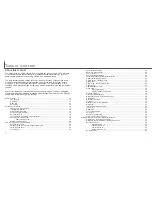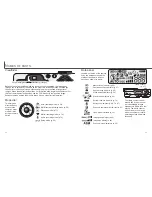
Autoflash - the flash fires automatically in
low-light and backlit conditions.
Red-eye reduction - the flash fires twice
before the main flash burst to reduce red-
eye; an effect caused by light reflected from the retina. Use in low-light conditions when
taking photographs of people or animals. The pre-flashes contract the pupils of the
subject’s eyes.
32
A
UTO
-
RECORDING MODE
Autoflash
Fill-flash
Flash cancel
Autoflash with
red-eye reduction
Flash cancel - the flash will not fire. Use flash cancel when flash photography is pro-
hibited, natural light is desired to illuminate the subject, or the subject is beyond the
flash range. The camera-shake warning may appear when flash cancel is selected.
Fill-flash - the flash fires with each expo-
sure regardless of the amount of ambient
light. Fill-flash can be used to reduce harsh
shadows caused by strong direct light or
sunshine.
To set the flash mode, sim-
ply press the flash mode
button (1) on the back of
the camera until the
desired mode is displayed.
1
Flash modes
The orange flash lamp next to the viewfinder indicates the status of the flash. When the
lamp blinks quickly, the flash is charging and the shutter will not release. The lamp
goes out when the flash is charged and ready to fire.
33
If the shutter speed falls below the point where the camera can be safely hand held,
the camera-shake warning will appear on the LCD monitor and the green focus lamp
will blink slowly. Camera shake is slight blurring caused by subtle hand motion and is
more pronounced at the telephoto setting of the lens than at the wide-angle setting.
Although the warning appears, the shutter can still be released. If the warning appears,
the following steps can be taken:
• Place the camera on a tripod.
• Use the built-in flash.
• Zoom the lens towards the wide-angle position until the warning
disappears.
Camera-shake warning
Flash range - auto-recording mode
The camera will automatically control the flash output. For well-exposed images, the
subject must be within the flash range. Because of the optical system, the flash range
is not the same at the lens’ wide-angle position as it is at the telephoto position.
Wide-angle position
Telephoto position
0.5m ~ 2.9m (1.6 ft. ~ 9.5 ft.)
0.5m ~ 1.7m (1.6 ft. ~ 5.6 ft.)
Flash signals
Summary of Contents for DiMAGE F100
Page 1: ...INSTRUCTION MANUAL E...
































